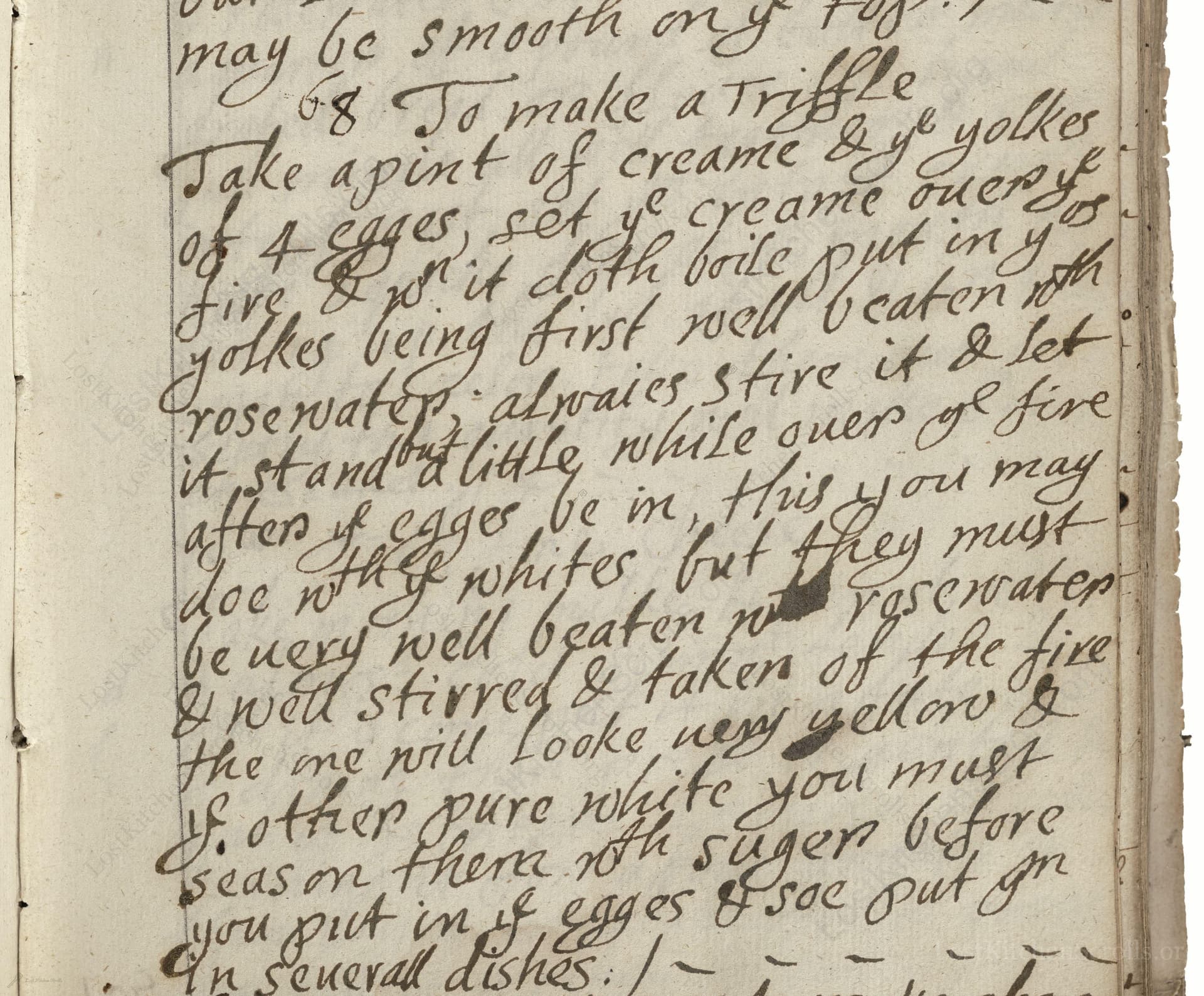To Make A Triffle
From the treasured pages of Cookbook of L. Cromwell
Written by L. Cromwell

To Make A Triffle
"Take a pint of creame & ye yolkes of 4 egges, set ye creame ouer ye fire & when it doth boile put in ye yolkes being first well beaten with rosewater, alwaies stire it & let it stand but a little while ouer ye fire after ye egges be in, this you may doe with whites but they must be very well beaten wth rosewater & well stirred & taken of the fire the one will Looke very yellow & ye other pure white you must season them wth suger before you put in ye egges & soe put in severall dishes: / -"
Note on the Original Text
Recipes from the period were commonly brief, written for experienced cooks who required only a prompt rather than detailed instruction. The spelling ('egges', 'creame', 'stire') reflects early modern English orthography. Quantities and times are imprecise, trusting the cook’s skill. 'Rosewater' was an essential flavoring before vanilla became widely available. This recipe is less a 'trifle' in the modern sense and more akin to a simple custard, highlighting the evolution of the recipe through history.

Title
Cookbook of L. Cromwell (1650)
You can also click the book image above to peruse the original tome
Writer
L. Cromwell
Era
1650
Publisher
Unknown
Background
Step back into the sumptuous kitchens of the 17th century, where L. Cromwell’s collection stirs up a medley of grand flavors and old English culinary traditions—a true feast for culinary historians and curious cooks alike.
Kindly made available by
Folger Shakespeare Library
This trifle recipe hails from the 17th-century English household of Lady Cromwell, a period when trifles were still evolving from simple, creamy desserts to the more elaborate layered confections we associate with the term today. The recipe showcases a luxurious use of cream, eggs, sugar, and perfumed rosewater—a sweet treat likely reserved for festive occasions in wealthier homes of the Stuart era. The directions display the suggestive experimenting of the time, inviting cooks to try the dessert both as golden-yellow with yolks and pristine-white with whites—a playful demonstration of culinary creativity in a time before refrigeration and mass-produced desserts.

The cook would have used a metal or earthenware saucepan to heat the cream over an open hearth or fire. Beating the eggs was accomplished with a whisk or fork, and the mixture was stirred constantly with a wooden spoon or spatula. The finished trifle would be poured into small dishes or shallow bowls, likely made of pewter, pottery, or glass for serving.
Prep Time
10 mins
Cook Time
5 mins
Servings
4
We've done our best to adapt this historical recipe for modern kitchens, but some details may still need refinement. We warmly welcome feedback from fellow cooks and culinary historians — your insights support the entire community!
Ingredients
- 1 pint (2 cups) double cream
- 4 large egg yolks (or 4 large egg whites for white version)
- 2–3 teaspoons rosewater
- 2 tablespoons white sugar
Instructions
- Begin by gently heating 1 pint (2 cups) of double cream in a saucepan.
- In a separate bowl, thoroughly beat the yolks of 4 large eggs with 2 teaspoons of rosewater and 2 tablespoons of sugar.
- Once the cream comes to a gentle boil, remove it from the heat and gradually whisk in the egg yolk mixture, ensuring constant stirring to prevent curdling.
- Return the pan to a very low heat for just a minute or two, stirring continuously, until the custard thickens slightly.
- For a pure white version, repeat this process with the 4 egg whites instead of yolks, but ensure the whites are well whisked with the rosewater before adding.
- Serve each version in separate dishes.
Estimated Calories
300 per serving
Cooking Estimates
You will spend a few minutes preparing the ingredients and mixing, then a short time cooking the cream and custard on the stove. Each serving is about 300 calories if you divide the recipe into four portions.
As noted above, we have made our best effort to translate and adapt this historical recipe for modern kitchens, taking into account ingredients nowadays, cooking techniques, measurements, and so on. However, historical recipes often contain assumptions that require interpretation.
We'd love for anyone to help improve these adaptations. Community contributions are highly welcome. If you have suggestions, corrections, or cooking tips based on your experience with this recipe, please share them below.
Join the Discussion
Rate This Recipe
Dietary Preference
Main Ingredients
Culinary Technique
Occasions

Den Bockfisch In Einer Fleisch Suppen Zu Kochen
This recipe hails from a German manuscript cookbook compiled in 1696, a time whe...

Die Grieß Nudlen Zumachen
This recipe comes from a rather mysterious manuscript cookbook, penned anonymous...

Ein Boudain
This recipe comes from an anonymous German-language manuscript cookbook from 169...

Ein Gesaltzen Citroni
This recipe, dating from 1696, comes from an extensive anonymous German cookbook...
Browse our complete collection of time-honored recipes



